Memories, life lessons: Stories from World War II veterans
Every month, an average of 300 World War II veterans pass away according to Melinda Luna, Philippine Veterans Affairs Office (PVAO) Veterans Records Management Division chief. As of March 2015, there are only 12,297 of them left. They are ordinary men who had lived, fought and survived through an extraordinary time in history. To date, each one of them receives a monthly pension of P5,000 plus P1,700 as Total Administrative Disabilty Pension, barely enough to cover their cost of living by current standards. Their sacrifices for the freedom of succeeding generations should not be forgotten.
JOSE “LOLO PEPING” PEREZ JAVIER
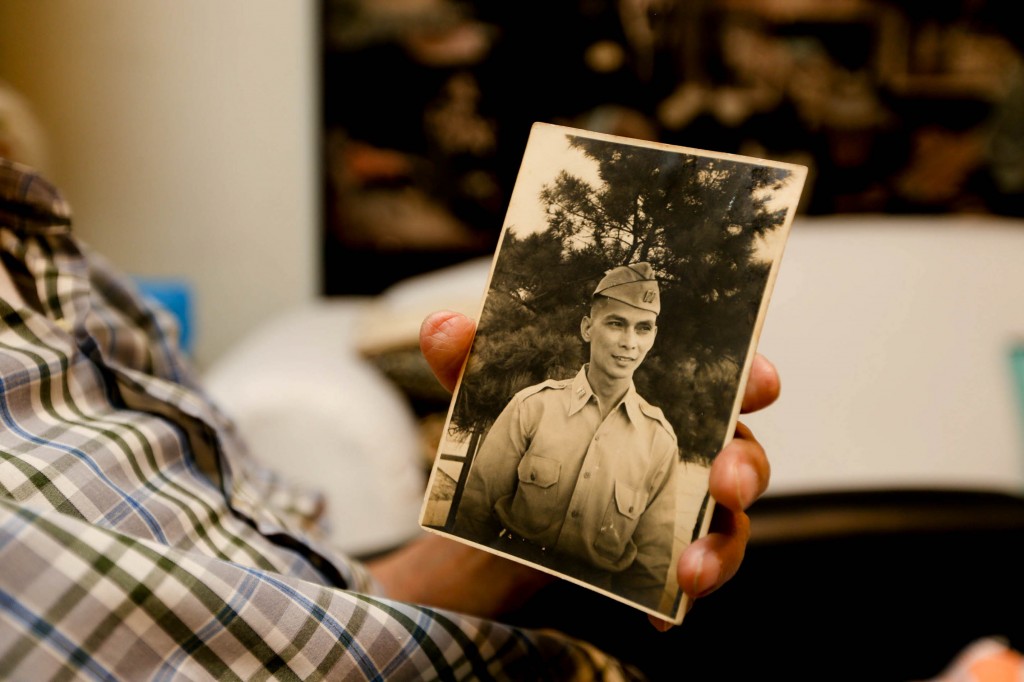
World War II veteran Dr. Jose Perez Javier, 105 years old, shows an old photo of himself in his youth. Javier was among those who survived the Death March. INQUIRER PHOTO/LYN RILLON

World War II veteran Dr. Jose Perez Javier, 105 years old, is assisted by his wife Filomena at their home in Quezon City. Javier was among those who survived the Death March. INQUIRER PHOTO/LYN RILLON
Capt. Jose “Lolo Peping” Perez Javier, is a doctor by profession.
He was born on February 19, 1910 in Laoag, Ilocos Norte. He took up Medicine at the University of Sto.Tomas. To date, he is officially recognized as its oldest senior alunmnus.
Asked if he had wanted to take up any (sub) specialties before World War II broke out, it took him some time to answer. He can’t hear very well, his wife Filomena explained. She leaned over to him to gently explain the question. Hovering nearby to assist him were their son Martin and daughter Lulu, who displayed the same consideration and care as their mother.
Javier was inducted into the United States Army Forces in the Far East or USAFFE on Sept. 1, 1941, where he served as Executive Officer of the 21st Medical Batallion under the 21st Infantry Division. He and his older brother, Engineer Fernando “Panding” Perez Javier, are both survivors of the Bataan Death March and were prisoners-of-war in the former Camp O’Donnell in Tarlac. It was one of the largest concentration camps for POWs of the Japanese Imperial Forces where around 25,000 Filipino and 6,000 American soldiers died. In October 1944, he joined the guerilla movement, working as regimental surgeon of the 66th Infantry Regiment of the United States Armed Forces in the Philippines-Northern Luzon.
At the end of the war, he eventually took a post as Philippine Scouts-US Army surgeon in Okinawa, Japan where he served for 38 years, raising a brood of nine children with his wife.
A report from the US Army Reserve Personnel Center, Dept. of the Army, states that he”…served as member of the Philippine Commonwealth Army including the recognized guerillas in the service of the Armed Forces of the United States from Dec. 1941-June 10, 1946, the date honorably discharged.”
He attributes his survival during those times to prayers and his faith in God.
He is now 105 years old, while his brother Lolo Panding (based in Baguio) is 107 years old, considered the Philippines’ oldest living WWII veteran.
ALBERTO CARIAGA SOLOMON
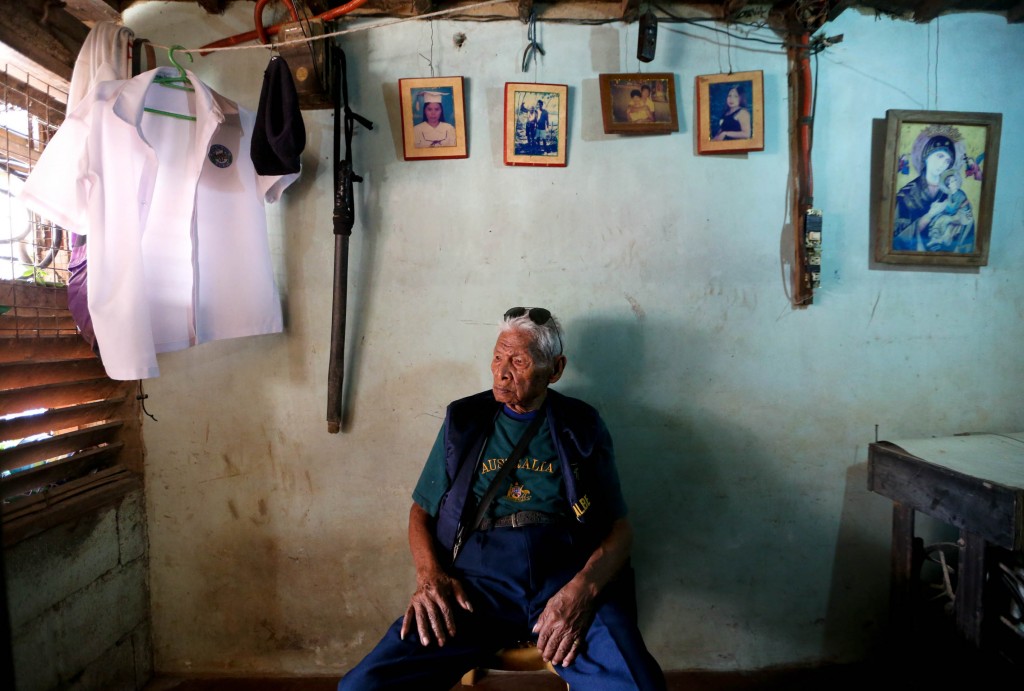
World War II veteran Alberto Solomon, 94 years old, inside his small house in Barangay Santolan, Pasig City. On the walls are old photos of some of his children and a nephew. At left is a “sibat” that his daughter Emalyn says he brings with him when he goes out. Mr. Solomon is physically fit for his age, but two of his grandsons still stay with him here to care for his needs. INQUIRER PHOTO/LYN RILLON

94 year old World War II veteran Alberto Solomon’s daughter Emalyn explains something to him in a louder voice as he has difficulty hearing. As a father, she describes him as a teacher who taught his children how to survive and help others without expecting in return, to avoid trouble and live peacefully. She and her children take care of him, with his house located right beside hers in a depressed area in Barangay Santolan, Pasig City. INQUIRER PHOTO/LYN RILLON
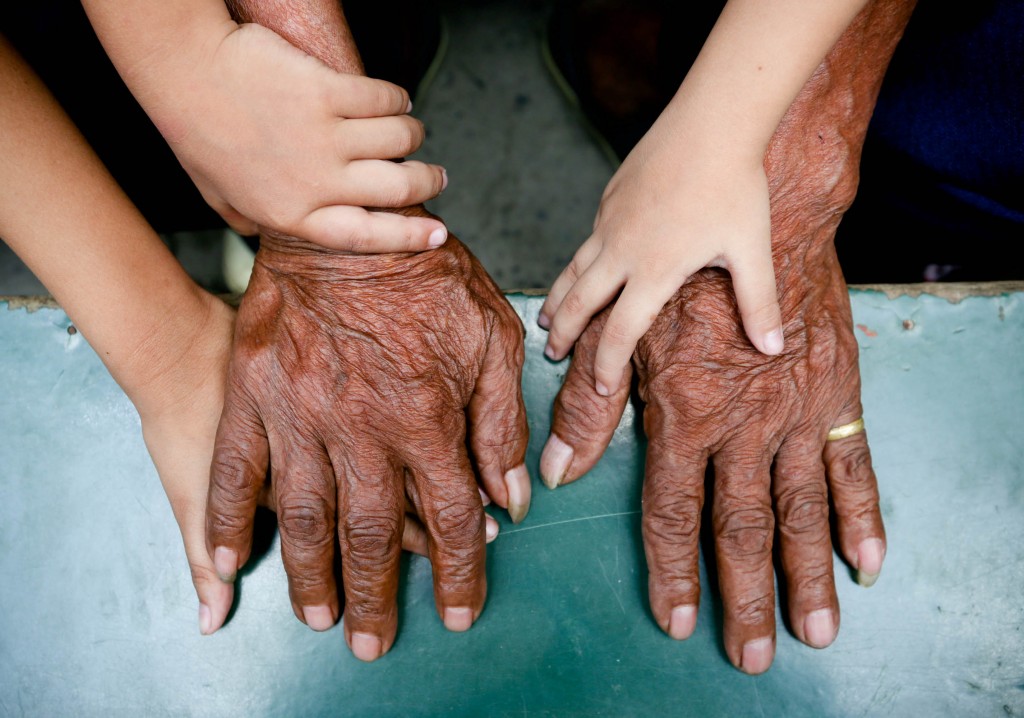
World War II veteran Alberto Solomon, 94 years old. Gnarled hands roughened by years of hard work held by his young grandchildren. Solomon was called to active duty and inducted to the USAFFE in December 1941 and was sent as part of the campaign in Mindanao. In May 1942, he became a POW of Japanese forces and was sent to Camp O’Donell in Tarlac, one of the largest concentration camps of the Japanese forces. INQUIRER PHOTO/LYN RILLON
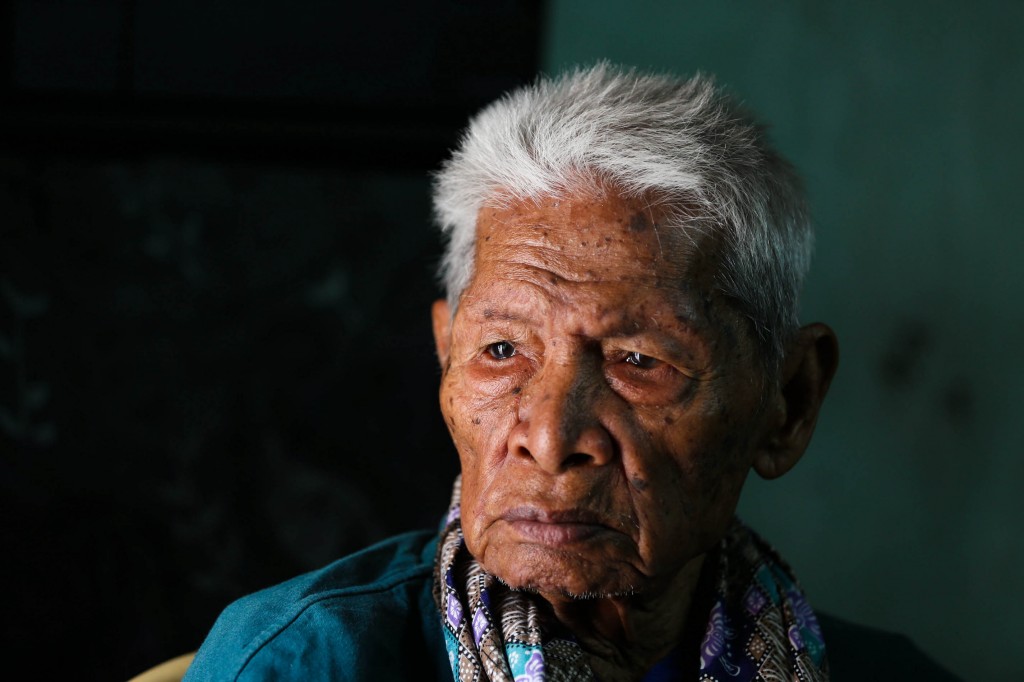
World War II veteran Alberto Solomon, 94 years old. Born on August 21, 1920. INQUIRER PHOTO/LYN RILLON
Alberto Cariaga Solomon was born in Lalibertad, Negros Oriental on August 21, 1920.
As a boy, Solomon lost his mother at an early age. When his father remarried, he experienced maltreatment from his stepmother, causing him to run away from home.
He was called to active duty and inducted to the USAFFE in December 1941 and was sent as part of the campaign in Mindanao. He recalls handling machine guns in battle. During an encounter in Iligan, he was fired at by what he believes to be Koreans allied with Japanese soldiers. As a private, he received a base pay of P14.00 plus P8.00 allowance, monthly. In May 1942, he became a POW of Japanese forces and was sent to Camp O’Donell in Tarlac.
Now in his twilight years, he enjoys tending to a small vegetable garden near the banks of Pasig River. One of his hobbies is taking care of his fighting cocks for “sabong” or cockfighting and enjoying the company of his numerous “apo.” In fact, the only time his weathered face cracked into a smile for a photo was when he held one of his youngest grandchildren in his arms, together with the boy’s older cousins.
Today, he resides with his extended family in Barangay Santolan in Pasig City.
His daughter Emalyn Hagos, describes her father as a living example of what he preaches. “He taught us, his children, how to survive. To help others without expecting something in return. To avoid trouble and leave peaceably with others.”
PORFIRIO GABEATAN LAGUITAN
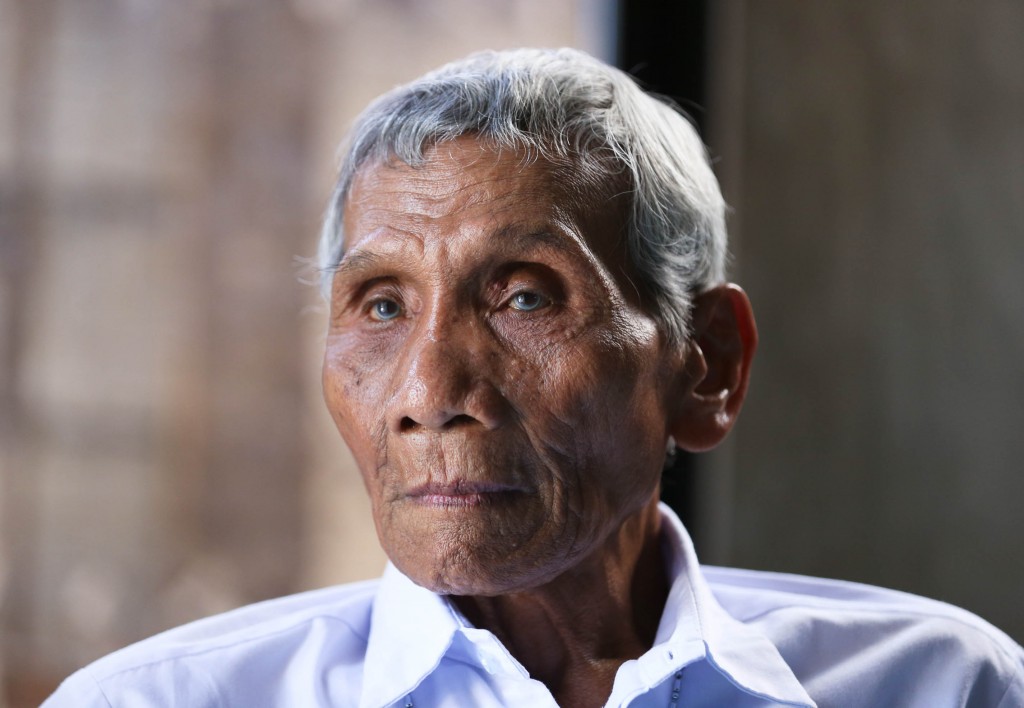
World War II veteran Porfirio G. Laguitan, 91 years old. He was an informer for guerillas, reporting enemy position and activities during the war. After WWII, he worked for the US forces looking for deserters in the Japanese army for turn-over to the USAFFE headquarters and also worked under the US military police command to maintain peace and order. He has 7 children and more than two dozen grandchildren. INQUIRER PHOTO/LYN RILLON
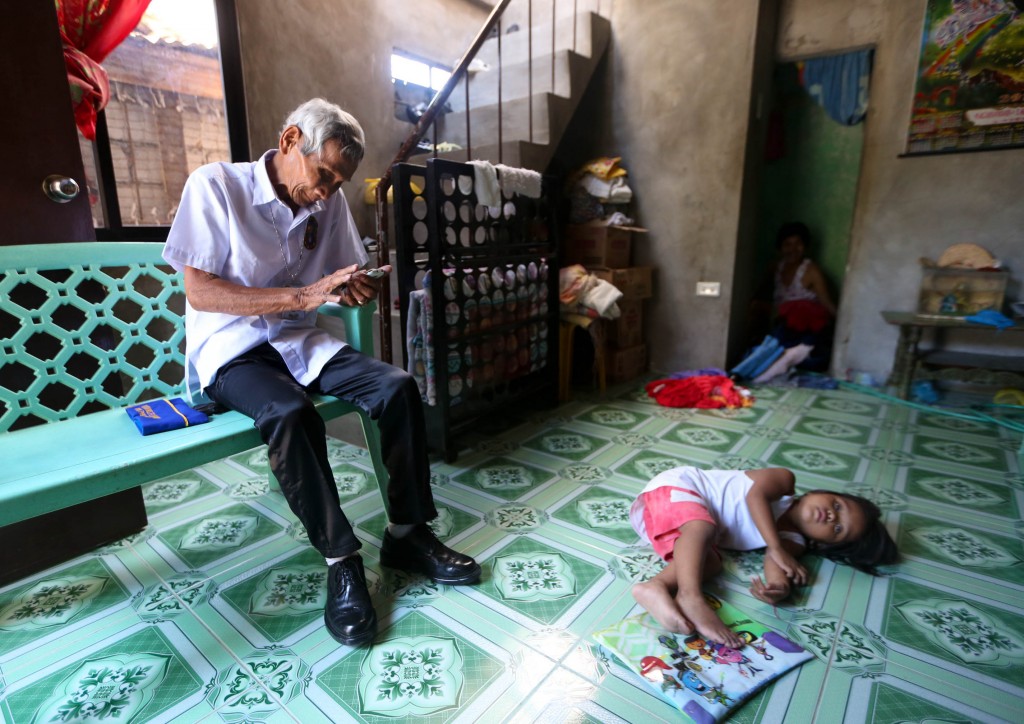
World War II veteran Porfirio G. Laguitan, 91 years old, checking his mobilephone while one of his grandchildren plays on the floor insid ehis home in Taguig City. INQUIRER PHOTO/LYN RILLON
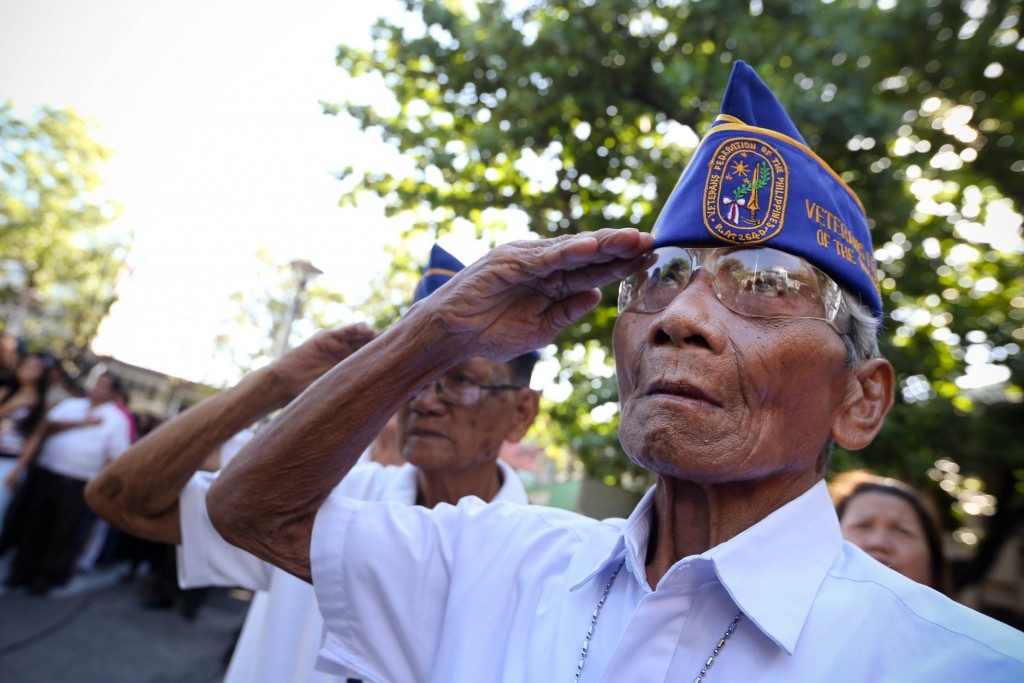
World War II veteran Porfirio G. Laguitan, 91 years old, saluting during the singing of the national anthem on Monday flag ceremony in Taguig City Hall. INQUIRER PHOTO/LYN RILLON
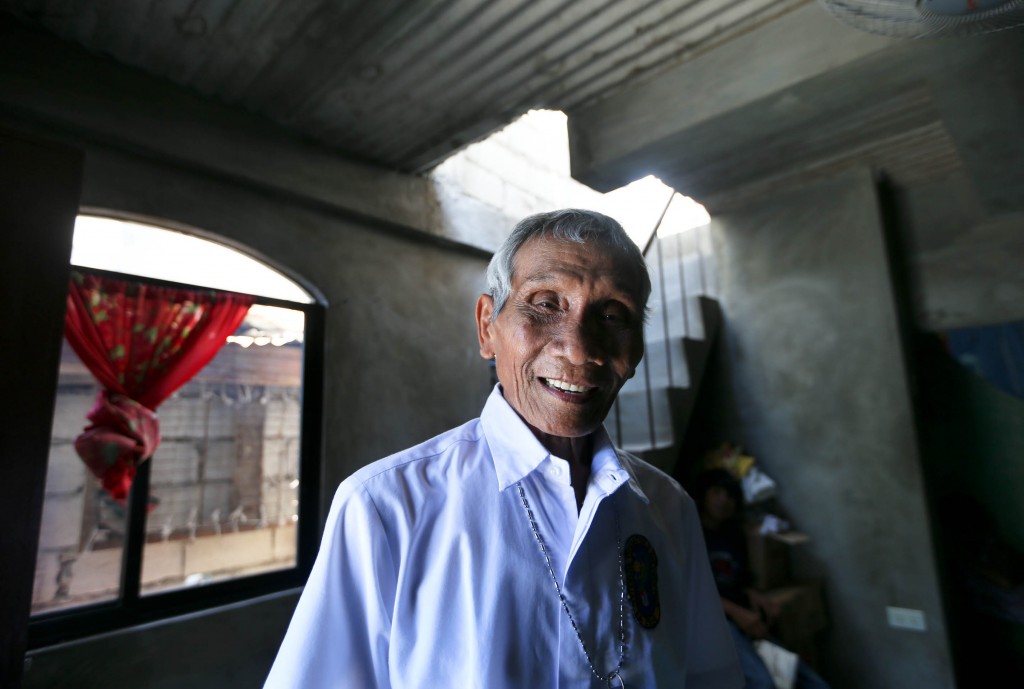
World War II veteran Porfirio G. Laguitan, 91 years old. He was an informer for guerillas, reporting enemy position and activities during the war. After WWII, he worked for the US forces looking for deserters in the Japanese army for turn-over to the USAFFE headquarters and also worked under the US military police command to maintain peace and order. He has 7 children and more than two dozen grandchildren. INQUIRER PHOTO/LYN RILLON
Small of stature and with a wiry build, Pfc. Porfirio Gabeatan Laguitan walks with the sprightliness and gait of a person half his age. At 94 years old, he attends Monday flag ceremonies at the Taguig City Hall. He wears his neatly-pressed white polo with veteran’s badge, blue cap and government identification tag.
He easily navigates the steps built onto a sloping pathway leading to his residence in Lower Bicutan, Taguig City. He proudly gestures to the other simple housing beside his, “My children live here.”
He is a pleasant man who likes to smile. “Ayoko ma-konsumisyon (I don’t want to be burdened with problems),” he explained.
He was born in Pozorrubio, Pangasinan on February 10, 1924. During the war, he became an informer for guerillas, reporting enemy activities. After the Liberation, he worked by looking for deserters of the Japanese Army and turning them over to the USAFFE headquarters. PVAO records show that he was assigned with the 13th Military Police Co. Philippine Army on March 27, 1945.
Today, Laguitan busies himself by personally helping in finishing the construction of his house. He takes good care of himself by, among other things, not smoking and drinking Bear Brand milk.
His life lesson is simple. “Learn how to make sacrifices and to endure (difficulty).”
PEDRO SANTOS GUTIERREZ
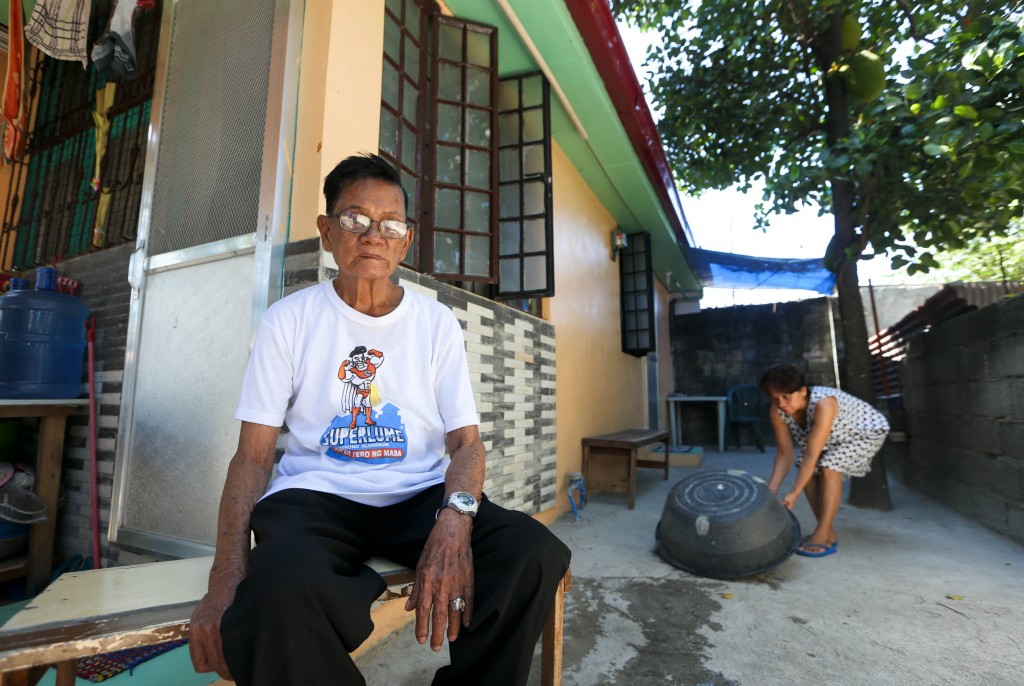
World War II veteran Pedro Santos Gutierrez, 87 years old. He has a house in Bataan but stays with his daughter Eva Natividad (R) partly for better access to free medical services for veterans in Manila. INQUIRER PHOTO/LYN RILLON
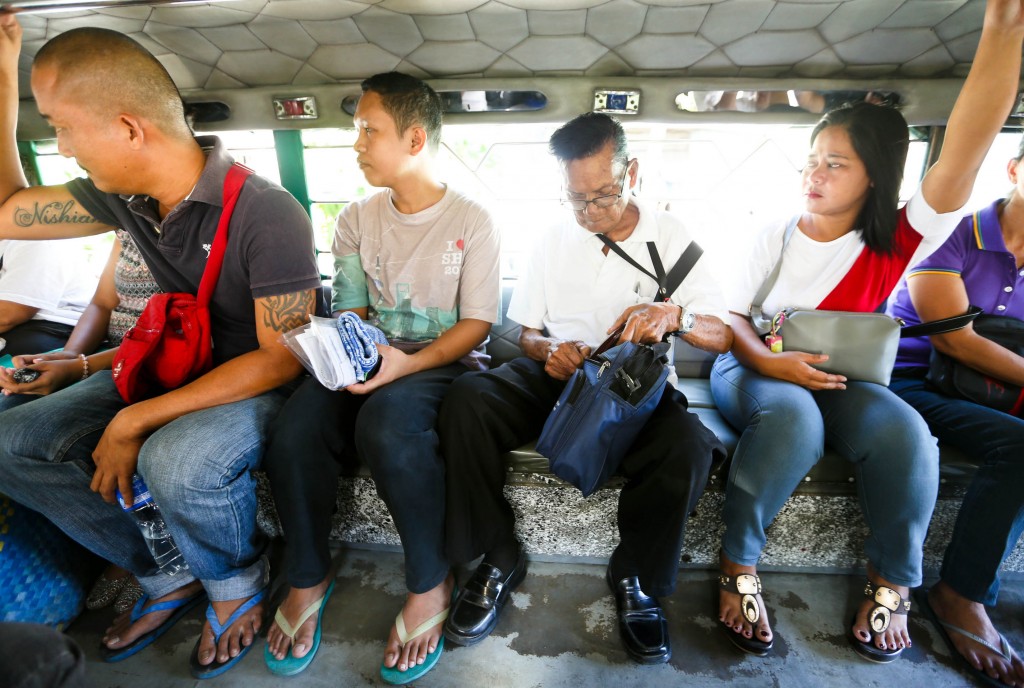
World War II veteran Pedro Santos Gutierrez (3rd from left), 87 years old. Born October 19, 1927. Voluntarily joined guerilla forces in 1942. Mr. Gutierrez prefers to commute by himself to and from his home in Taguig City. INQUIRER PHOTO/LYN RILLON
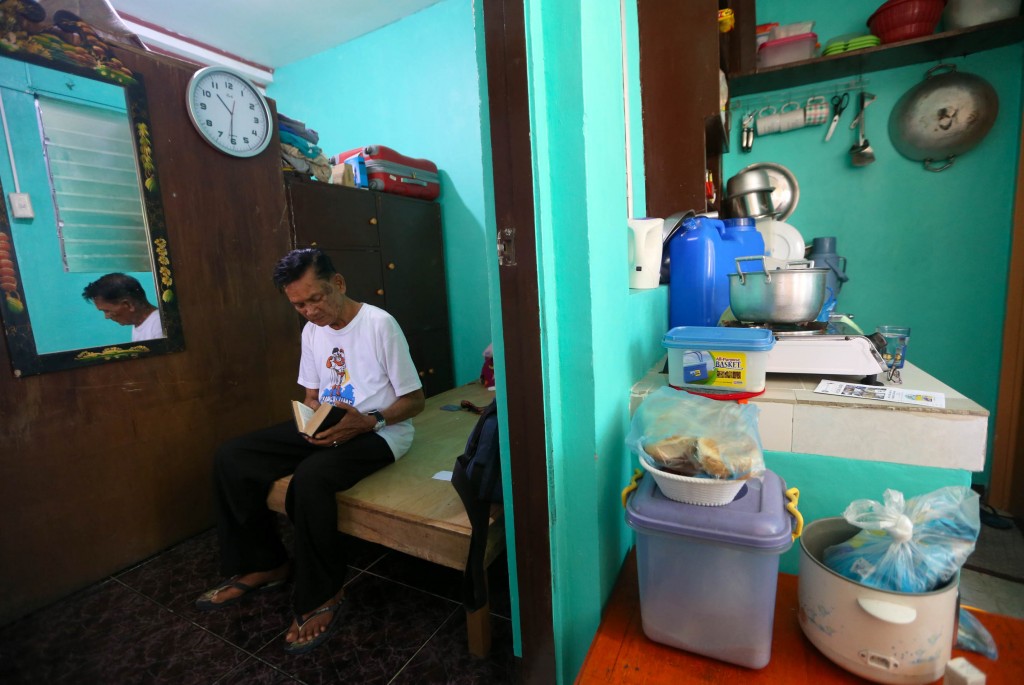
World War II veteran Pedro Santos Gutierrez, 87 years old, spends time reading his Bible in a house he shares with his daughter Eva Natividad. INQUIRER PHOTO/LYN RILLON

World War II veteran Pedro Santos Gutierrez, 87 years old. Born October 19, 1927. He voluntarily joined guerilla forces in 1942. Recalls an encounter with Japanese forces where one of the soldiers threw a grenade at his group, shrapnel hitting his face and limbs. INQUIRER PHOTO/LYN RILLON
Pfc. Pedro Santos Gutierrez is a very independent man. For one, he prefers to take public transportation to and from his home by himself, without any assistance.
Quiet and serious, he relates his wartime experience with some hesitancy. He had been a part of Marking’s Fil American Troops organized by Marcos Villa Agustin, a former amateur boxer and bus driver from Manila who used to transport USAFFE soldiers to the battle frontlines in Bataan. Marking’s organization developed a reputation for ruthlessness during the war.
“I joined the guerillas voluntarily to have a fighting chance (at survival), to be able to hold arms to defend ourselves.”
One of his unforgettable experiences was in an encounter with enemy forces where one Japanese soldier threw a grenade at his group, shrapnel hitting his face and limbs. The left side of his head still bears visible scars. Another was seeking refuge and getting trapped in an old church in Taguig (then part of Rizal province) surrounded by Japanese soldiers until American forces arrived.
When the war ended, he found employment as a driver for the US Army. He received free training that would later bring him to Guam to work as a food inspector. Later in his career, he ventured into a construction job in Saudi Arabia in the mid-1970s before the term overseas Filipino worker or OFW became a byword.
“There were very few Filipinos working there back then,” he says.
These days, he spends part of his time reading his Bible, resting on a simple wooden bed in a rented house in Lower Bicutan, Taguig City, where he is cared for by his married daughter, Eva Natividad.
Gutierrez was born in Bagumbayan, Taguig in October 19, 1927.
JOSE S. QUILATAN
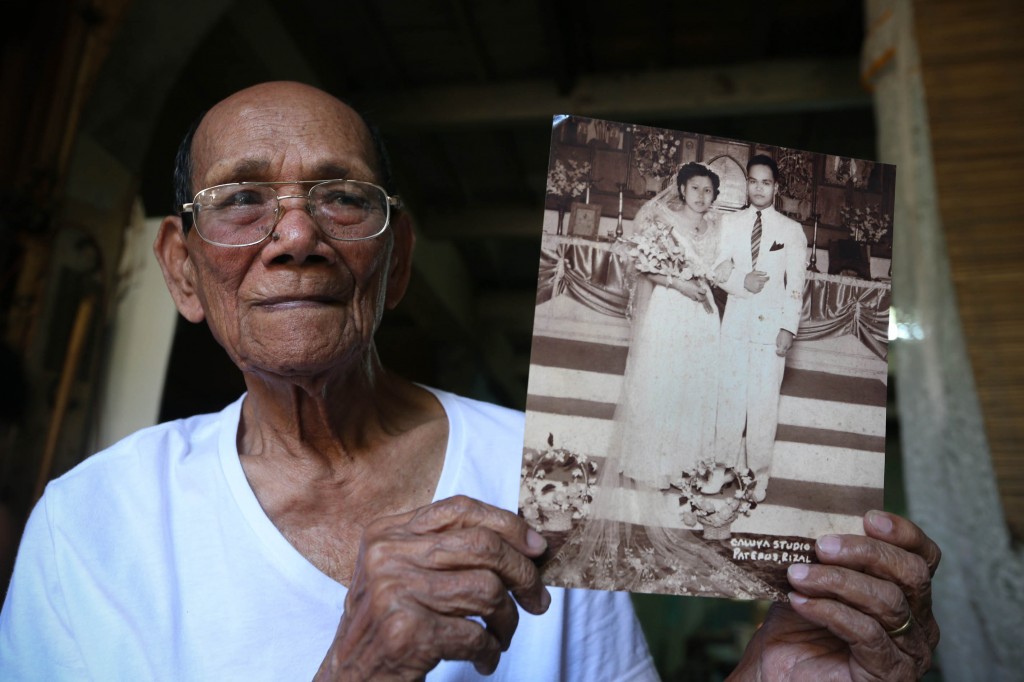
100 year old World War II veteran Jose Santiago Quilatan Sr. showing a black-and-white photo of his wedding day with his young bride Lourdes Dimaguila, then 20 years old and he at 26. INQUIRER PHOTO/LYN RILLON

World War II veteran Jose Santiago Quilatan Sr.’sGSIS Member’s Service Record from his first employment in July 1937 (pre-war) and his last one listed on February 1979. INQUIRER PHOTO/LYN RILLON

World War II veteran Jose Santiago Quilatan Sr., 100 years old, photographed outside his home in Taguig City. Born on February 15, 1915. During the war, Quilatan experienced being assigned to supply food and clothing to guerillas, providing information on the movement of enemy forces. He worked as a watchman at the Bureau of Health in Manila. INQUIRER PHOTO/LYN RILLON
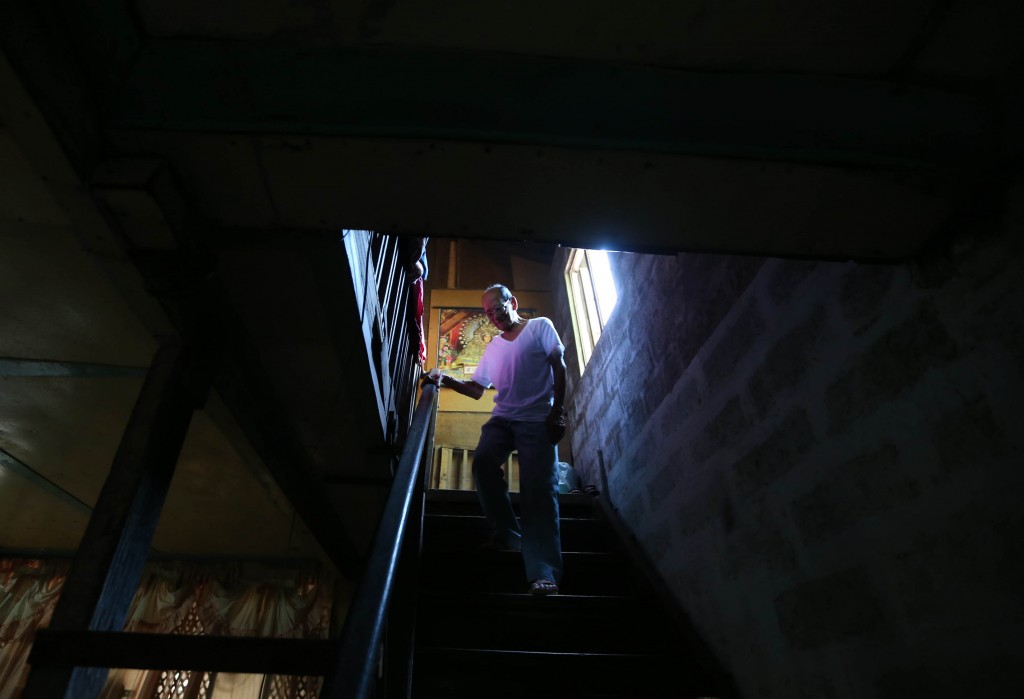
World War II veteran Jose Santiago Quilatan Sr., 100 years old, photographed at his home in Taguig City. Born on February 15, 1915. During the war, Quilatan experienced being assigned to supply food and clothing to guerillas, providing information on the movement of enemy forces. He worked as a watchman at the Bureau of Health in Manila. INQUIRER PHOTO/LYN RILLON
Last March 28, 2015, Sgt. Jose S. Quilatan received a Certificate of Recognition for achieving the Centenarian age and consistent dedication as a World War II veteran during the Barangay Assembly Day in Barangay Ibayo-Tipas, Taguig City.
Quilatan Sr. was born in Taguig on February 15, 1915. He enjoys good health and retains a keen memory.
An organized person, he showed his personal and professional documents all neatly categorized in different marked folders. One contains some yellowed elementary school and high school cards showing his grades in various subjects, while another holds his government employment records from 1937 to the 70s. A dog-eared envelope has some family pictures and a clipped newspaper article on himself.
During the war, he was inducted into the Hunters ROTC Guerillas 47th Regiment on November 8, 1942 in Taguig, Rizal as a corporal and placed under the Supply Unit. His duties included supplying materials such as food and clothing to the guerilla combat teams which were undergoing military training at Mt. Buso-buso. He was promoted to Sergeant and assigned to the Trigger Unit in 1943: the group was noted for neutralizing enemy soldiers and “Makapilis” in the provinces of Laguna and Rizal. He reported enemy movement and watched out closely for the latter, who were persons acting as spies for the Japanese forces, faces hidden inside a “bayong” or native bag to hide their identity. According to government records, he had been so effective at his tasks that Japanese authorities targeted him.
All his daring exploits seemed at odds with this slightly-built, soft-voiced gentleman. He says he doesn’t know why he has been blessed with such a long life, but is contented. DL
RELATED STORIES
10 living war vets honored by AFP